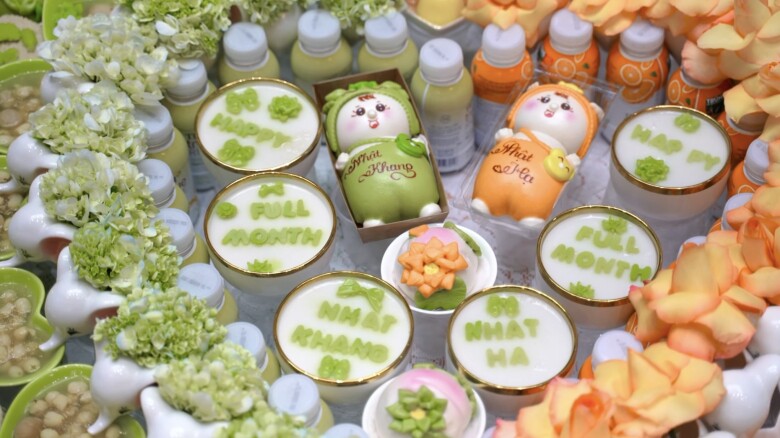
Vietnamese actress Phuong Oanh recently shared a heartwarming video expressing her emotions about giving birth to her twin “dragon babies,” Jimmy and Jenny. The new mom also revealed intimate photos from the couple’s at-home full-month celebration, offering a glimpse into this special tradition.



The full-month celebration included a carefully prepared offering to the “Mụ,” a traditional Vietnamese ritual to thank the birth goddesses and seek blessings for the newborns. Phuong Oanh’s offering was a simple yet thoughtful spread, featuring steamed chicken, sticky rice, sweet mung bean soup, fruits, steamed buns, a cake, betel leaves and areca nuts, incense, and candles. The color scheme of green and orange represented her children, with green symbolizing Jimmy and orange for Jenny.
While the offering was visually appealing, the most heartwarming moment was when shark Binh held his son, and Phuong Oanh cradled her daughter as they performed the “Khai Hoa” ritual. This symbolic gesture of feeding the babies their first solid food was a memorable milestone for the family.


The at-home celebration was also attended by close family members, including the couple’s parents, marking a special occasion to introduce the twins’ names: Nhat Khang and Nhat Ha.
What is the “Cung Mu” (Full-Month) Ceremony?
The “Cung Mu” ceremony is a traditional Vietnamese ritual performed to express gratitude to the “Mu,” the birth goddesses believed to preside over childbirth and shape the child’s destiny. This ceremony is commonly practiced in several Asian cultures, including Vietnam, and is typically held when the baby is 3 days old (“day cu”), 1 month old (“day thang”), 100 days old (“day tuoi”), and 1 year old (“day noi”).
Offerings for the Ceremony
For the “Cung Mu” ceremony, a plate of betel leaves and areca nuts is prepared, with 12 small pieces and one larger piece, symbolizing the 12 birth goddesses and the main goddess.
The preparation of offerings is a meticulous process. Typically, there are 12 small offerings for the 12 birth goddesses and one larger offering for the main goddess. These may include:
– Paper votive objects
– Betel leaves and areca nuts
– Children’s toys
– Live crabs, snails, or shrimp, or their cooked counterparts. There should be 12 items of equal size and one larger or three smaller ones. After the ceremony, these are released into a pond or body of water.
– Sweets and candies, divided into 12 portions and one larger or extra portion
– Savory dishes: sticky rice, steamed chicken, rice, soup, side dishes, and white liquor
– More sweets and candies, again divided into 12 portions and one larger or extra portion
– Incense and flowers of various colors, along with ceremonial money and clear water.
Arranging the Offering Table
In addition to preparing the offerings, it is essential to arrange the full-month offering table correctly. Following traditional customs, two tables are used, placed one above the other, with a gap of no more than 10 cm between them. The arrangement follows the principle of “East for the flower vase and West for the offerings.”
The Ceremony and Prayers
The full-month ceremony and prayers are significant aspects of this tradition, as they express gratitude for the healthy birth of the child and introduce the new family member to the ancestors and extended family.
After setting up the offerings, an elder from the family will light incense and recite the following prayer:
“Today, on the (day)… of the (month)… (year)…, our (grandson or granddaughter) of the (family name)…, named… has turned one month old. We present this offering to invite the Twelve Birth Goddesses and the Three Virtues to witness and accept our gratitude. We pray that you will continue to bless (name…) with strength, good health, and wisdom. May our family be filled with joy and happiness.”
The full-month ceremony is a beautiful tradition that reflects the unique cultural heritage and ancestral worship of the Vietnamese people, celebrating the birth of a child and wishing for their healthy development.



































